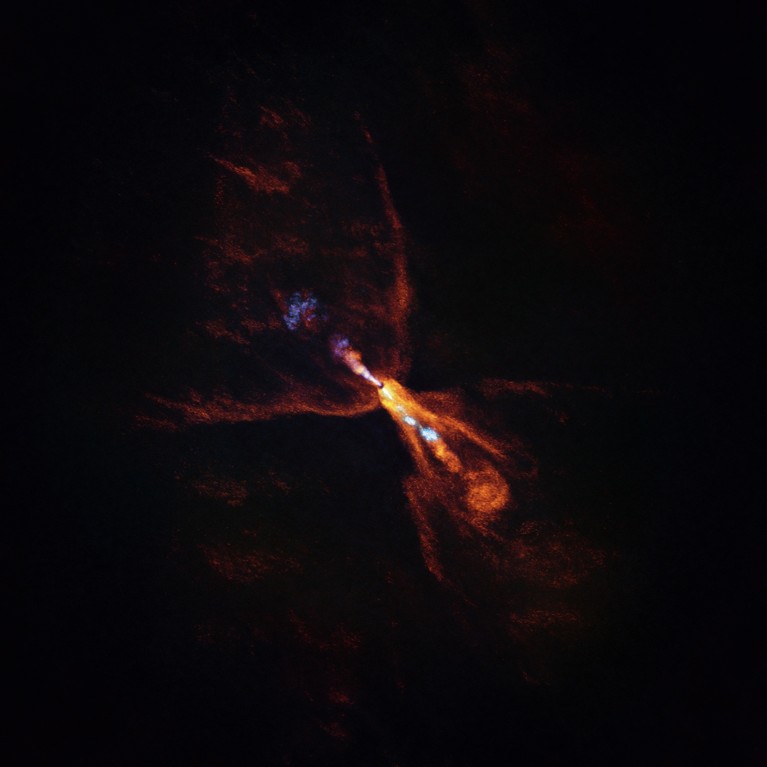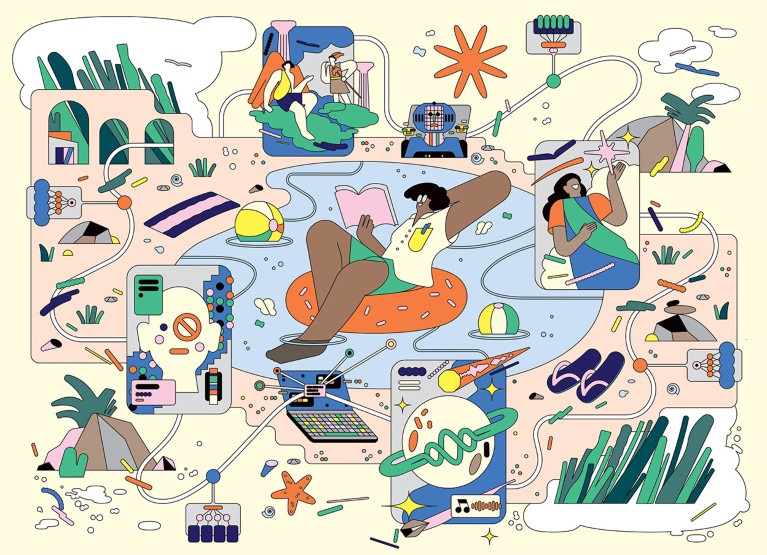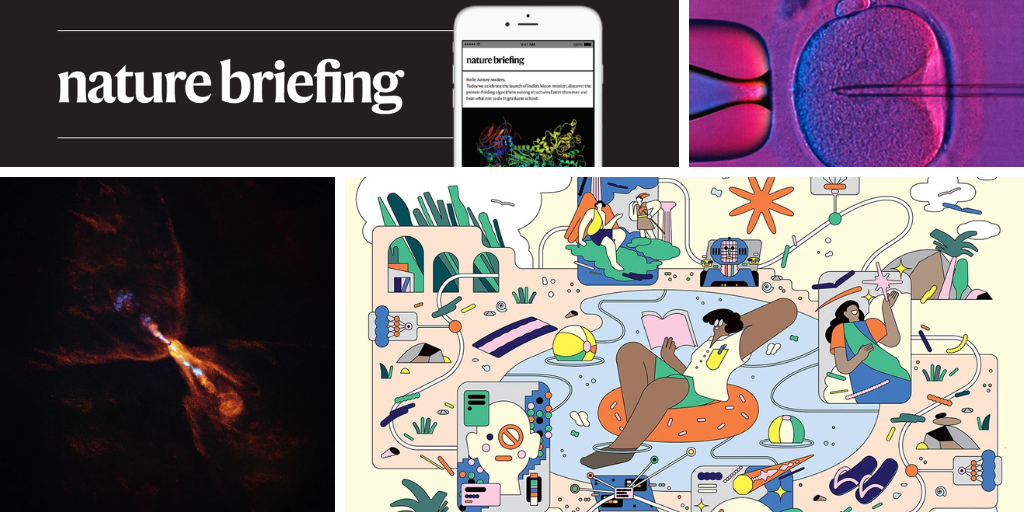You have full access to this article via your institution.
Hello Nature readers, would you like to get this Briefing in your inbox free every day? Sign up here.

HOPS-315, as imaged by the Atacama Large Millimeter-submillimeter Array in Chile (orange is carbon monoxide blowing away from the central star, blue is silicon monoxide).Credit: ALMA(ESO/NAOJ/NRAO)/M. McClure et al.
Astronomers have spotted a solar system beyond our own in its very earliest stages of formation. Using both ground- and space-based telescopes, the team zeroed in on the young star, named HOPS-315, at the start of its planet-forming era. The baby star was at just the right orientation for astronomers to get a glimpse of its surrounding disk of gas and dust, which is usually obscured by jets of gas pumped out by newborn stars. Researchers have long sought such a system to help them understand the humble beginnings of our own.
Eight children conceived through a controversial reproductive technique called mitochondrial donation are living healthy lives. The procedure, dubbed ‘three-person in vitro fertilization’, involves transferring the nucleus of a fertilized egg that has faulty mitochondria into a donor egg with healthy ones. As a result, the children carry nuclear DNA from a biological mother and father, alongside mitochondrial DNA from a separate egg donor. The technique aims to prevent babies inheriting harmful mutations from their mother’s mitochondrial DNA, which can cause debilitating diseases that affect power-hungry tissues such as the heart and muscles.
Reference: New England Journal of Medicine paper 1 & paper 2
Drosophila research hasn’t fallen victim to the ‘reproducibility crisis’, a new study suggests. Of more than 1,000 claims about the fruit flies’ immunity in scientific papers published over some 50 years, at least 61% are verifiable through replication. Only 7% had been challenged and proved not to be reproducible. “There is a narrative of a ‘reproducibility crisis’ in science, which sounds dramatic,” says study co-author and Drosophila researcher Mark Hanson, but adds that the scientists themselves are rarely that worried. In the field of fly genetics, “we constantly build on each other’s work”, he says.
Reference: bioRxiv preprint 1 & preprint 2
Kimi K2, launched by Moonshot AI, is the second powerful artificial intelligence (AI) model to emerge from China, after DeepSeek shocked the world with its launch of R1 in January. Kimi K2 appears to excel at coding, scoring high in tests of code-related tasks. A big advantage of both models is that they are open-weight, meaning they can be downloaded and built upon by researchers for free. Kimi K2 is “the new best open model in the world”, wrote machine-learning researcher Nathan Lambert in a social post.
Features & opinion

Illustration: Bratislav Milenkovic
Nature contributors’ pick of the best popular science and scholarly books to read now (even if it’s winter — I see you, Southern Hemisphere) include a lyrical exploration of the science of sounds and a deep dive into the reproducibility crisis in biomedical science.
Biomedical researcher João Conde has seen first-hand what US cuts to science funding means: his cancer-research work in Portugal, done in collaboration with colleagues in the United Kingdom and United States, is now under threat. “The dangers of depending so much on one nation are becoming clear,” he says. Funding and decision-making responsibilities should be spread among more countries, he argues, and all this must be underpinned by shared databases and research-management platforms.
We have a host of information about ourselves at our fingertips, but often choose to avoid or ignore it. The reasons for this information avoidance fall into three broad categories, explains psychologist Jeremy Foust: protecting a belief, avoiding an undesired action and reducing negative emotions. What’s less clear cut is the extent to which it impacts us. Choosing not to ‘doomscroll’ negative news can benefit our mental health in the short term, but to only engage with what we want to hear can lead us down a rabbit hole of increasingly biased views.
Today I’m reminded that you can find friends in unlikely places. Even, it appears, if you’re two different species that are usually predator and prey.
Scientists who placed camera traps across the Amazon rainforest have caught footage of ocelots (Leopardus pardalis) and opossums (Didelphis marsupialis) seemingly hanging out “like two old friends walking home from a bar”, says behavioural ecologist Isabel Damas-Moreira.
The team theorize that sticking around an ocelot shields an opossum from detection by larger predators, but I prefer to think that they just enjoy each other’s company.
If you have any feedback on this newsletter, just between friends, your emails are welcome at [email protected].
Thanks for reading,
Jacob Smith, associate editor, Nature Briefing
With contributions by Flora Graham
• Nature Briefing: Careers — insights, advice and award-winning journalism to help you optimize your working life
• Nature Briefing: Microbiology — the most abundant living entities on our planet — microorganisms — and the role they play in health, the environment and food systems
• Nature Briefing: Anthropocene — climate change, biodiversity, sustainability and geoengineering
• Nature Briefing: AI & Robotics — 100% written by humans, of course
• Nature Briefing: Cancer — a weekly newsletter written with cancer researchers in mind
• Nature Briefing: Translational Research — covers biotechnology, drug discovery and pharma


